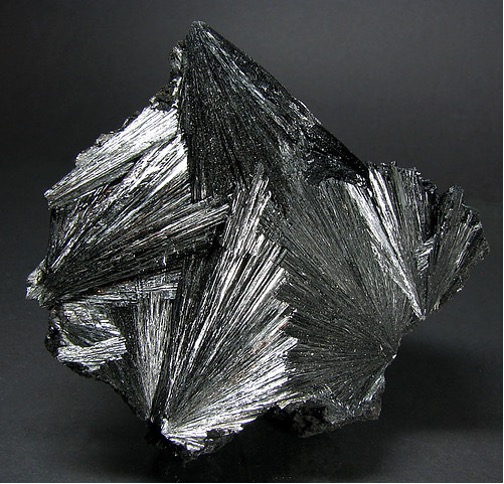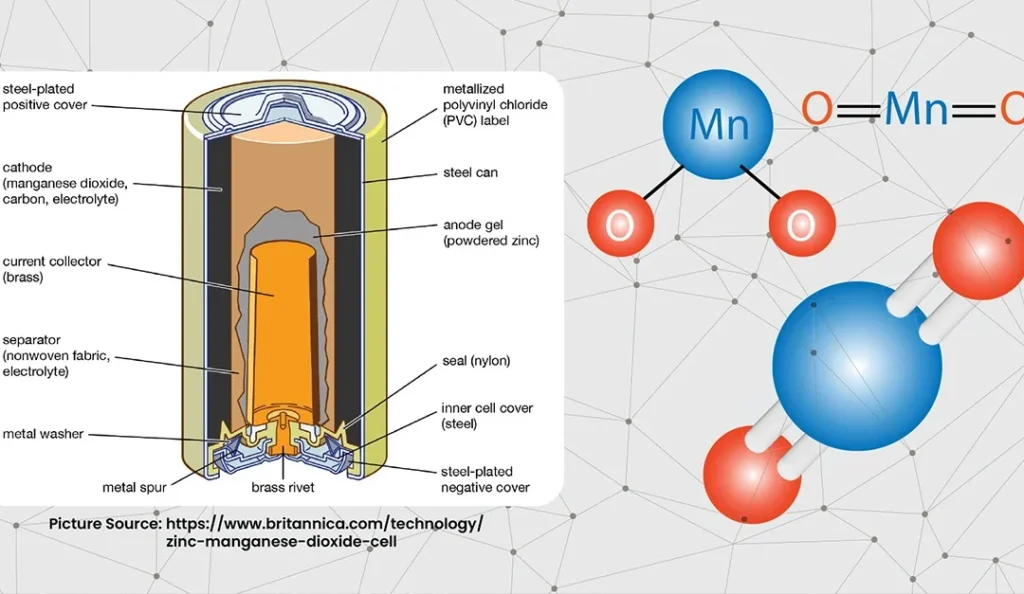Manganese dioxide is an extremely versatile compound and is associated with a rich history in various industries. Known for its chemical stability, effectiveness, and affordability, manganese dioxide finds its indispensable utility in modern applications and technology – from environmental remediation to steel production, electronic equipment and battery technologies.
Where does manganese dioxide come from?
Manganese dioxide occurs naturally in a variety of minerals – principally as pyrolusite (MnO2), which is the major economic source of the compound. It is generally found as a black, amorphous mineral, often with a granular, fibrous, or columnar structure (see below). The name ‘pyrolusite’ stems from the Greek words for ‘fire’ and to ‘wash’, in reference to its use in removing tints from glass.


What do we use MnO2 for?
Environmental Applications
One of the primary uses of manganese dioxide lies in environmental remediation and purification processes:
- Water Treatment: MnO2 is widely used in water treatment facilities to remove iron, manganese, and hydrogen sulfide through oxidation and filtration processes. It helps in improving water quality by eliminating odors and harmful substances, thus making water safer for consumption.
- Air Purification: in air purification systems, manganese dioxide acts as a catalyst to convert harmful gases like sulfur dioxide (SO2) and nitrogen oxides (NO1-2) into less harmful compounds, thereby reducing air pollution levels.
Battery Technology
Manganese dioxide plays a crucial role in battery manufacturing, particularly in alkaline batteries:
- Alkaline Batteries: MnO2 serves as a key component in the cathode of alkaline batteries, enhancing the batteries’ energy density and performance. These batteries are widely used in consumer electronics, toys, and other portable devices due to their longer shelf life and reliability. The growing demand for batteries has greatly intensified the demand for the manganese dioxide.
Chemical Industry
In the chemical sector, manganese dioxide finds applications in various processes:
- Chemical Synthesis: it is utilised as an oxidising agent in organic chemistry reactions, facilitating the production of organic compounds and intermediates essential for pharmaceuticals, dyes, and other chemical products.
Metallurgy and Glass Production
- Metallurgical Processes: MnO2 is employed in metallurgical applications, especially in steel production, where it helps remove sulfur and oxygen impurities, thereby improving the quality and durability of steel.
- Glass Industry: it is used in the glass industry as a decolorising and oxidising agent, ensuring the production of clear and high-quality glass products.
Electronics and Catalysts
- Electronics: MnO2 is integral to the manufacturing of electronic components such as resistors and capacitors due to its electrical conductivity and stability under varying conditions.
- Catalysts: it serves as a catalyst in chemical reactions, promoting oxidation-reduction processes in industrial applications ranging from fuel cells to chemical production.
Other Applications
- Paints and Pigments: in the paint industry, manganese dioxide is used as a pigment to impart specific colors and improve the durability and coverage of coatings.
- Medical: in medicine, it has potential applications in certain treatments and research due to its biocompatibility and oxidative properties.
Outlook
Manganese dioxide, with its multifaceted properties and wide-ranging applications, will continue to be a crucial component across various industries, as it exemplifies the synergy between scientific innovation and industrial application. As technology advances and new challenges arise, manganese dioxide will remain a reliable ally in the quest for cleaner, more efficient, and sustainable solutions. A fast increase in the manufacturing of EV vehicles, the green revolution and the changeover to cleaner solutions have led to the need to expand the production and sophistication of MnO2 metal and derivatives. In essence, the uses of manganese dioxide underscore its importance as a cornerstone of modern industry and innovation, promising continued relevance in shaping the future of diverse sectors globally.







